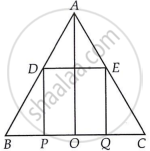Advertisements
Advertisements
प्रश्न
D and E are the mid-points of the sides AB and AC of ∆ABC and O is any point on side BC. O is joined to A. If P and Q are the mid-points of OB and OC respectively, then DEQP is ______.
पर्याय
a square
a rectangle
a rhombus
a parallelogram
उत्तर
D and E are the mid-points of the sides AB and AC of ∆ABC and O is any point on side BC. O is joined to A. If P and Q are the mid-points of OB and OC respectively, then DEQP is a parallelogram.
Explanation:

In ΔABC, D and E are the mid-points of sides AB and AC, respectively.
By mid-point theorem,
DE || BC ...(i)
DE = `1/2` BC
Then, DE = `1/2` [BP + PO + OQ + QC]
DE = `1/2` [2PO + 2OQ] ...[Since, P and Q are the mid-points of OB and OC respectively]
⇒ DE = PO + OQ
⇒ DE = PQ
Now, in ΔAOC, Q and E are the mid-points of OC and AC respectively.
∴ EQ || AO and EQ = `1/2` AO [By mid-point theorem] ...(iii)
Similarly, in ΔABO,
PD || AO and PD = `1/2` AO [By mid-point theorem] ...(iv)
From equations (iii) and (iv),
EQ || PD and EQ = PD
From equations (i) and (ii),
DE || BC (or DE || PQ) and DE = PQ
Hence, DEQP is a parallelogram.
APPEARS IN
संबंधित प्रश्न
In a ΔABC, BM and CN are perpendiculars from B and C respectively on any line passing
through A. If L is the mid-point of BC, prove that ML = NL.
Show that the line segments joining the mid-points of the opposite sides of a quadrilateral
bisect each other.
In the given figure, `square`PQRS and `square`MNRL are rectangles. If point M is the midpoint of side PR then prove that,
- SL = LR
- LN = `1/2`SQ

In triangle ABC, angle B is obtuse. D and E are mid-points of sides AB and BC respectively and F is a point on side AC such that EF is parallel to AB. Show that BEFD is a parallelogram.
Side AC of a ABC is produced to point E so that CE = `(1)/(2)"AC"`. D is the mid-point of BC and ED produced meets AB at F. Lines through D and C are drawn parallel to AB which meets AC at point P and EF at point R respectively. Prove that: 4CR = AB.
The diagonals AC and BD of a quadrilateral ABCD intersect at right angles. Prove that the quadrilateral formed by joining the midpoints of quadrilateral ABCD is a rectangle.
The quadrilateral formed by joining the mid-points of the sides of a quadrilateral PQRS, taken in order, is a rectangle, if ______.
P, Q, R and S are respectively the mid-points of sides AB, BC, CD and DA of quadrilateral ABCD in which AC = BD and AC ⊥ BD. Prove that PQRS is a square.
Show that the quadrilateral formed by joining the mid-points of the consecutive sides of a square is also a square.
Prove that the line joining the mid-points of the diagonals of a trapezium is parallel to the parallel sides of the trapezium.
